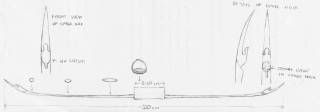The wooden one is the same basic design of handle, but with wider flat wooden limbs rather than the more D shaped horn limbs. It's a cylinder of bamboo or wood, with a plug, and one limb glued in place. The other limb is seated into the slot between the plug and handle, and the bow is strung. The "reverse" handle is pretty much an Indonesian innovation.
Draw lengths are in the 22"-26" range. Draw weights up to 40-45# - they are used for hunting, especially from blinds. Their competition is to sit cross-legged like that and shoot at gourds, wads of cloth or styrofoam balls of varying sizes, suspended at various heights off the ground up to about 6 ft. Arrows are 30" or more, 1/4" diameter or a bit less, and often made from sanded round splits from a thick walled bamboo.
The take-down bow was also use against the Japanese during WWI, and in later skirmishes against government soldiers as well. Take-down meant "easy to hide"....
This sketch was made by an Indonesian friend, of a regional military museum specimen which was used during their 1945 War of Independence. It has single piece bamboo limbs with horn tips, and is almost exactly 48" TtT
